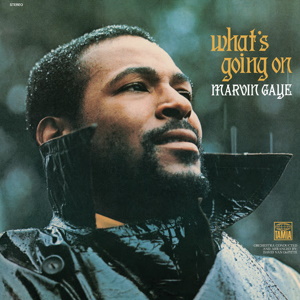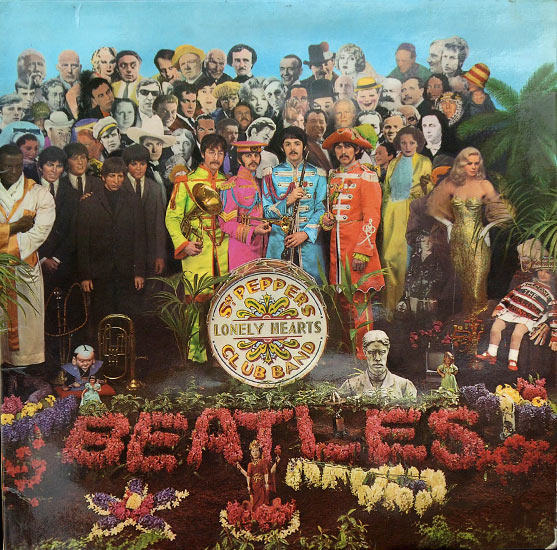milo
Jack L. Jones
Marvin defeated II,
phuq and Appetite for Destruction and Nevermind to reach the final.

What's Going On is the eleventh studio album by soul musician Marvin Gaye, released May 21, 1971, on the Motown-subsidiary label Tamla Records.[1] Recording sessions for the album took place in June 1970 and March–May 1971 at Hitsville U.S.A., Golden World and United Sound Studios in Detroit and at The Sound Factory in West Hollywood, California.
The first Marvin Gaye album credited as being produced by the artist himself, What's Going On is a unified concept album consisting of nine songs, most of which lead into the next. It has also been categorized as a song cycle; the album ends on a reprise of the album's opening theme. The album is told from the point of view of a Vietnam War veteran returning to the country he had been fighting for, and seeing nothing but injustice, suffering and hatred.
What's Going On was the first album on which Motown Records' main studio band, the group of session musicians known as the Funk Brothers, received an official credit. The album features introspective lyrics and socially conscious themes of drug abuse, poverty, and the Vietnam War. What's Going On was both an immediate commercial and critical success and has endured as a classic of early-1970s soul. A deluxe edition set of the album was released on February 27, 2001, and featured a rare live concert shot at Washington, D.C.'s Kennedy Center from May 1972.
In worldwide critics', artists' and public surveys, it has been voted one of the landmark recordings in pop music history and is considered to be one of the greatest albums ever made.[2] In 2003, the album was ranked number six on Rolling Stone's list of the "500 Greatest Albums of All Time", placing that same position nine years later.[3]
http://en.wikipedia.org/wiki/What's_Going_On_(Marvin_Gaye_album)
[video=youtube;inFDgCSGWDs]http://www.youtube.com/watch?v=inFDgCSGWDs[/video]
v
Sgt Peppers beat Second Toughest of the Infants, Dummy, Thriller and Exile On Main Street to reach the final.

Sgt. Pepper's Lonely Hearts Club Band is the eighth studio album by the English rock band the Beatles. Released on 1 June 1967, it was an immediate commercial and critical success, spending 22 weeks at the top of the albums chart in the United Kingdom and 15 weeks at number one in the United States. Time magazine declared it "a historic departure in the progress of music" and the New Statesman praised its elevation of pop to the level of fine art.[1] It won four Grammy Awards in 1968, including Album of the Year, the first rock LP to receive this honour.
In August 1966, the Beatles permanently retired from touring and began a three-month holiday from recording. During a return flight to London in November, Paul McCartney had an idea for a song involving an Edwardian era military band that would eventually form the impetus of the Sgt. Pepper concept. Sessions for the Beatles' eighth studio album began on 24 November in Abbey Road Studio Two, with the original intention to record an album of material that was to be thematically linked to their childhoods. Among the first tracks recorded for the project were "Strawberry Fields Forever" and "Penny Lane", but after pressure from EMI the songs were released as a double A-side single; they were not included on the album.
In February 1967, after recording "Sgt. Pepper's Lonely Hearts Club Band", McCartney suggested that the Beatles should release an entire album that would represent a performance by the fictional Sgt. Pepper band. This alter ego group would give them the freedom to experiment musically. During the recording sessions, the band endeavoured to improve upon the production quality of their prior releases. Knowing they would not have to perform the tracks live, they adopted an experimental approach to composition, writing songs such as "With a Little Help from My Friends", "Lucy in the Sky with Diamonds" and "A Day in the Life". The producer George Martin's innovative recording of the album included the liberal application of sound shaping signal processing and the use of a 40-piece orchestra performing aleatoric crescendos. Recording was completed on 21 April 1967. The cover, depicting the band posing in front of a collage of celebrities and historical figures, was designed by the English pop artists Peter Blake and Jann Haworth based on a sketch by McCartney.
Sgt. Pepper is regarded by musicologists as an early concept album that advanced the use of extended form in popular music while continuing the artistic maturation seen on the Beatles' preceding releases. It has been described as one of the first art rock LPs, aiding the development of progressive rock, and credited with marking the beginning of the Album Era. An important work of British psychedelia, the multigenre album incorporates diverse stylistic influences, including vaudeville, circus, music hall, avant-garde, and Western and Indian classical music. In 2003 the Library of Congress placed Sgt. Pepper in the National Recording Registry, honouring the work as "culturally, historically, or aesthetically significant".[2] That same year Rolling Stone magazine ranked it number one in its list of the 500 Greatest Albums of All Time. As of 2014 it has sold more than 30 million copies worldwide, making it one of the best selling albums of all time. The music scholar David Scott Kastan described it as "the most important and influential rock and roll album ever recorded".[3]
http://en.wikipedia.org/wiki/Sgt._Pepper's_Lonely_Hearts_Club_Band
[video=youtube;1T5fqLBhZgo]http://www.youtube.com/watch?v=1T5fqLBhZgo[/video]
phuq and Appetite for Destruction and Nevermind to reach the final.

What's Going On is the eleventh studio album by soul musician Marvin Gaye, released May 21, 1971, on the Motown-subsidiary label Tamla Records.[1] Recording sessions for the album took place in June 1970 and March–May 1971 at Hitsville U.S.A., Golden World and United Sound Studios in Detroit and at The Sound Factory in West Hollywood, California.
The first Marvin Gaye album credited as being produced by the artist himself, What's Going On is a unified concept album consisting of nine songs, most of which lead into the next. It has also been categorized as a song cycle; the album ends on a reprise of the album's opening theme. The album is told from the point of view of a Vietnam War veteran returning to the country he had been fighting for, and seeing nothing but injustice, suffering and hatred.
What's Going On was the first album on which Motown Records' main studio band, the group of session musicians known as the Funk Brothers, received an official credit. The album features introspective lyrics and socially conscious themes of drug abuse, poverty, and the Vietnam War. What's Going On was both an immediate commercial and critical success and has endured as a classic of early-1970s soul. A deluxe edition set of the album was released on February 27, 2001, and featured a rare live concert shot at Washington, D.C.'s Kennedy Center from May 1972.
In worldwide critics', artists' and public surveys, it has been voted one of the landmark recordings in pop music history and is considered to be one of the greatest albums ever made.[2] In 2003, the album was ranked number six on Rolling Stone's list of the "500 Greatest Albums of All Time", placing that same position nine years later.[3]
http://en.wikipedia.org/wiki/What's_Going_On_(Marvin_Gaye_album)
[video=youtube;inFDgCSGWDs]http://www.youtube.com/watch?v=inFDgCSGWDs[/video]
v
Sgt Peppers beat Second Toughest of the Infants, Dummy, Thriller and Exile On Main Street to reach the final.

Sgt. Pepper's Lonely Hearts Club Band is the eighth studio album by the English rock band the Beatles. Released on 1 June 1967, it was an immediate commercial and critical success, spending 22 weeks at the top of the albums chart in the United Kingdom and 15 weeks at number one in the United States. Time magazine declared it "a historic departure in the progress of music" and the New Statesman praised its elevation of pop to the level of fine art.[1] It won four Grammy Awards in 1968, including Album of the Year, the first rock LP to receive this honour.
In August 1966, the Beatles permanently retired from touring and began a three-month holiday from recording. During a return flight to London in November, Paul McCartney had an idea for a song involving an Edwardian era military band that would eventually form the impetus of the Sgt. Pepper concept. Sessions for the Beatles' eighth studio album began on 24 November in Abbey Road Studio Two, with the original intention to record an album of material that was to be thematically linked to their childhoods. Among the first tracks recorded for the project were "Strawberry Fields Forever" and "Penny Lane", but after pressure from EMI the songs were released as a double A-side single; they were not included on the album.
In February 1967, after recording "Sgt. Pepper's Lonely Hearts Club Band", McCartney suggested that the Beatles should release an entire album that would represent a performance by the fictional Sgt. Pepper band. This alter ego group would give them the freedom to experiment musically. During the recording sessions, the band endeavoured to improve upon the production quality of their prior releases. Knowing they would not have to perform the tracks live, they adopted an experimental approach to composition, writing songs such as "With a Little Help from My Friends", "Lucy in the Sky with Diamonds" and "A Day in the Life". The producer George Martin's innovative recording of the album included the liberal application of sound shaping signal processing and the use of a 40-piece orchestra performing aleatoric crescendos. Recording was completed on 21 April 1967. The cover, depicting the band posing in front of a collage of celebrities and historical figures, was designed by the English pop artists Peter Blake and Jann Haworth based on a sketch by McCartney.
Sgt. Pepper is regarded by musicologists as an early concept album that advanced the use of extended form in popular music while continuing the artistic maturation seen on the Beatles' preceding releases. It has been described as one of the first art rock LPs, aiding the development of progressive rock, and credited with marking the beginning of the Album Era. An important work of British psychedelia, the multigenre album incorporates diverse stylistic influences, including vaudeville, circus, music hall, avant-garde, and Western and Indian classical music. In 2003 the Library of Congress placed Sgt. Pepper in the National Recording Registry, honouring the work as "culturally, historically, or aesthetically significant".[2] That same year Rolling Stone magazine ranked it number one in its list of the 500 Greatest Albums of All Time. As of 2014 it has sold more than 30 million copies worldwide, making it one of the best selling albums of all time. The music scholar David Scott Kastan described it as "the most important and influential rock and roll album ever recorded".[3]
http://en.wikipedia.org/wiki/Sgt._Pepper's_Lonely_Hearts_Club_Band
[video=youtube;1T5fqLBhZgo]http://www.youtube.com/watch?v=1T5fqLBhZgo[/video]
